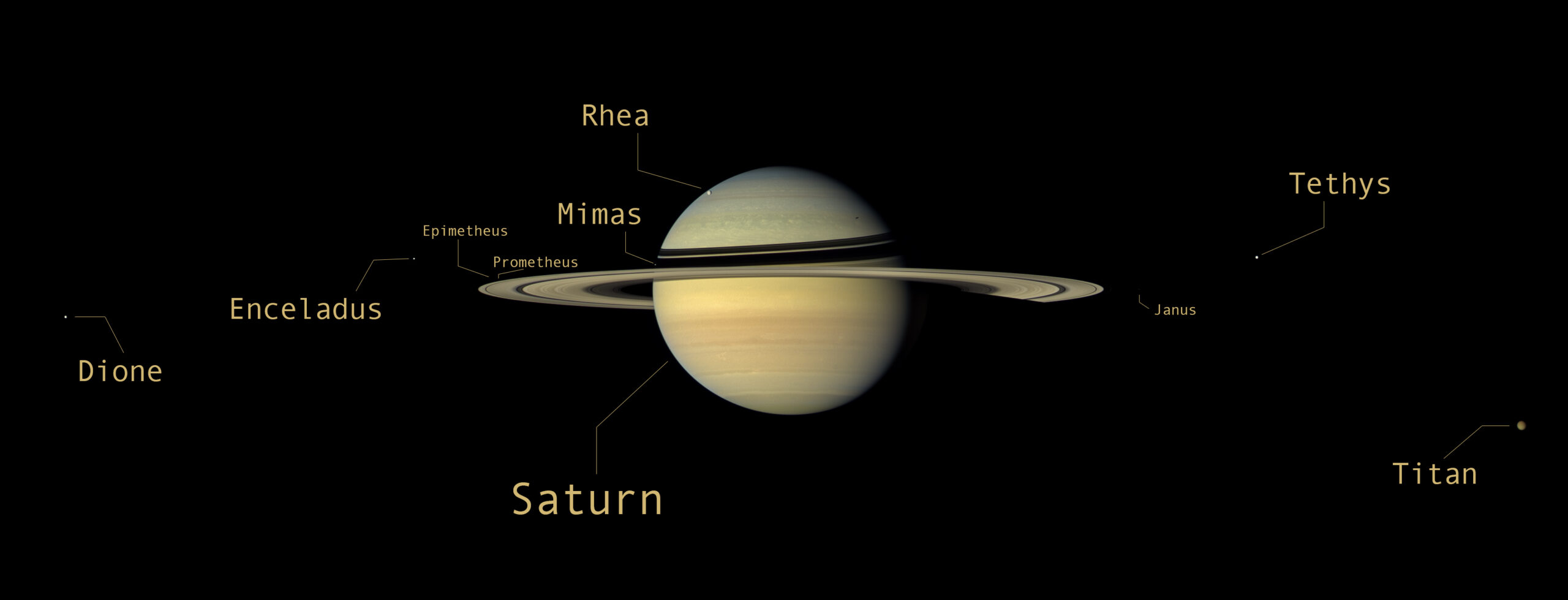From gas giants to ringed beauties, our solar system is a diverse and fascinating collection of celestial bodies, each with its own unique properties. One of the most recognizable planets is Saturn, known as the jewel of our solar system thanks to its breathtaking ring system. While its rings are indeed spectacular, Saturn’s weather and atmospheric conditions offer a mesmerizing and complex tableau that is intriguing to understand. Saturn’s atmospheric phenomena are as fascinating as they are complex, with a hydrogen and helium-dominated atmosphere, enormous, recognizable storms, distinct seasons and climate patterns, extreme temperature variations, and significant effects of its ring system on its overall weather.
Saturn’s Basic Atmospheric Structure
Saturn, the sixth planet from the sun, is a gas giant known for its rings and distinct weather patterns.
The primary component of Saturn’s atmosphere is hydrogen, which comprises up to 96% of the atmospheric gases. The remainder consists mainly of helium, with approximately 3%, and trace amounts of other substances such as methane, ammonia, and water vapor. This composition is similar to the early Universe’s, suggesting that it has changed little over the eons.
Saturn’s Atmospheric Layers
Saturn’s atmosphere is divided into several layers based on temperature and pressure: the troposphere, stratosphere, thermosphere, and exosphere. Each layer has distinct characteristics and contributes to the weather on Saturn.
The innermost layer, the troposphere
extends approximately 200 kilometers above Saturn’s visible cloud deck. It is primarily responsible for the planet’s iconic weather patterns, including hurricanes and storms. The troposphere is where temperatures descend below freezing, reaching a bitter -185 degrees Celsius at the uppermost fringe.
Above the troposphere lies the stratosphere
a layer that extends to about 700 kilometers. Unlike Earth, where the stratosphere is warmer than the troposphere, Saturn’s stratosphere is colder. This phenomenon is due to the absence of ozone layer that absorbs solar heat. Methane, the common element in Saturn’s stratosphere, contributes to heating this layer.
The thermosphere
Saturn’s third layer, extends from the stratosphere until around 2,000 kilometers above the planet’s surface. This layer sees an increase in temperature up to 375 degrees Celsius due to the absorption of UV radiation and interaction of Saturn’s magnetic field with the solar wind. Despite the high temperatures, an observer wouldn’t feel the heat due to the extremely low pressure here.
Finally, the outermost layer, the exosphere
extends from the thermosphere into space. This layer is hard to define due to its shift into the magnetosphere, where particles from the atmosphere interact with solar radiation. The shared interactions between these two regions are responsible for phenomena like auroras on the pole of Saturn.
Weather on Saturn
Saturn’s tumultuous weather is mostly confined to the troposphere, where the majority of clouds and storms form. Saturn’s distinctive bands are due to variability in the depth of cloud formations and wind speeds in the troposphere. Notably, Saturn harbors hurricane-like storms at its poles, with the most notable being the hexagonal storm at the planet’s north pole.
Understanding Saturn’s Unique Weather Patterns
The weather on Saturn, while seemingly chaotic, tends to maintain relative stability compared to that on Earth due to its considerably longer year, spanning about 29.5 Earth years. This results in Saturn’s seasonal transitions being significantly slower. Despite this stable tendency, the detailed processes relating to Saturn’s weather formation remain subjects of active scientific exploration. Indeed, the elaborate nature of Saturn’s atmosphere, coupled with its considerable distance from Earth, presents quite a challenging landscape for scientific investigation.
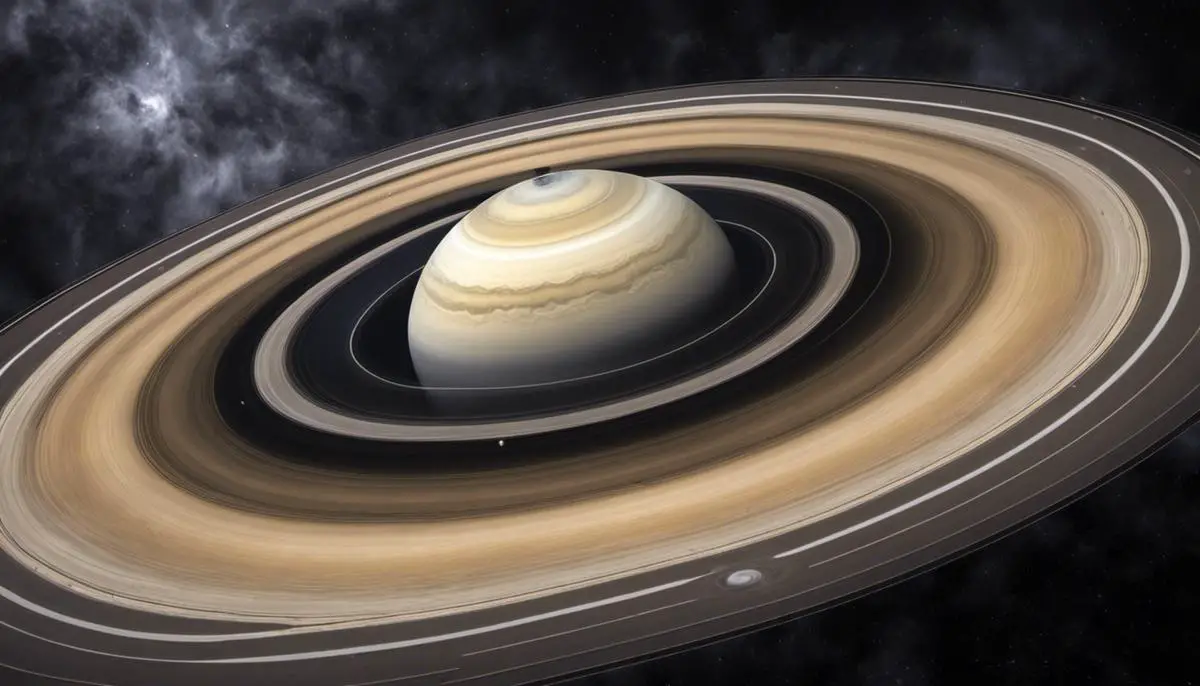
Saturn’s Iconic Storms
The Extravagant Phenomenon: Saturn’s Great White Spot
The majestic gas giant Saturn, hailed for its radiant rings, is home to some of the Solar System’s most awe-inspiring weather phenomena. Among the most remarkable is the Great White Spot, often referred to as the Great White Ovals. These colossal storm systems bear some resemblance to Earth’s most powerful hurricanes, although they occur on an unimaginably larger scale.
Storm Formation and Causes
The exact cause of these storms is a topic of intense scientific study. However, it is widely accepted that they are a result of Saturn’s quick rotation and massive atmospheric currents. When warm, moist gas from Saturn’s deep atmosphere rises and meets colder gas at the surface, it condenses and forms storm clouds. The rapid rotation of the planet, with a day lasting just 10.57 Earth hours, amplifies the strength and size of these storms.
Storm Characteristics and Longevity
One remarkable characteristic of these storms is their immense size and longevity. The largest recorded Great White Spot in 2010 covered nearly 10,000 km, which is roughly as large as the Earth’s circumference. They can also last for extended periods, spanning months or even several years, depending on their size and intensity. Unlike Earth’s short-lived storms, which lose their energy when they make landfall, Saturn’s storms maintain their fury for astonishing lengths of time as they traverse across vast expanses of gas.
Effects and Observations
The effects of these storms are substantial and can be observed even from Earth-based telescopes. They can cause drastic temperature fluctuations, changes in atmospheric composition, and visible scars on the cloud tops. The 2010 Great White Spot was so powerful that it triggered a rise in temperatures of about 80 degrees Celsius and caused a significant increase in ethylene, an odorless, colorless gas not typically seen on Saturn. The storm left a visible scar on Saturn’s northern hemisphere with a pale haze that lasted for weeks.
Saturn’s Unique Weather Phenomena
In addition to the Great White Spot, Saturn also experiences other unique weather phenomena. For example, the hexagonal storm at the North Pole, first observed by the Voyager spacecraft, remains an unexplained meteorological curiosity. Also, Saturn’s immense jet streams, some of the fastest in the solar system, contribute to the formation of its unparalleled atmospheric features.
A profound understanding of meteorology, both alien and terrestrial, can be derived from studying the captivating weather dynamics on Saturn, particularly its impressive storm systems. The phenomenal storms from this gas giant have continued to mesmerize astronomers and meteorologists alike over the years. Hence, Saturn’s dramatic weather serves as a vivid reminder of the incredible extraterrestrial phenomena that exist beyond the realms of our home planet, Earth.
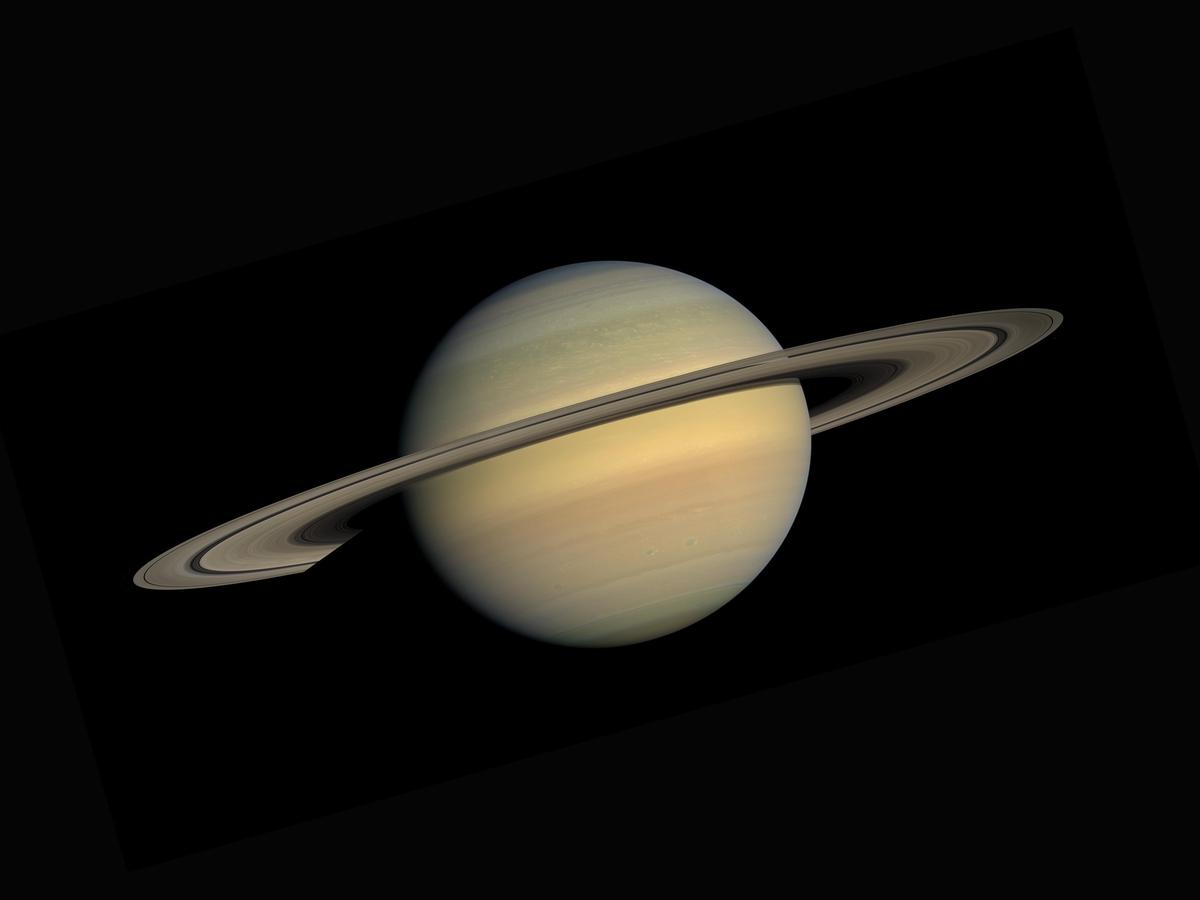
Saturn’s Seasons and Climate Patterns
Influence of Saturn’s Tilted Axis and Extensive Annual Orbit
The pronounced axial tilt and the considerable length of a year on Saturn, the sixth planet from the sun, primarily drive its unique climate and weather patterns. Much like our own Earth, Saturn’s axis also leans in relation to its orbit around the sun. This angular incline of about 26.7 degrees results in seasonal variations as different regions of the planet receive differential sunlight exposure throughout its orbital cycle.
Impact of Saturn’s Orbital Distance on Weather Variations
The distance of Saturn from the sun also plays a crucial role in its climate and weather variations. Saturn orbits at an average distance of about 886 million miles from the sun, nearly ten times the distance between Earth and the sun. As a result, the planet receives much less sunlight, making it significantly colder than Earth.
The reduced sunlight also impacts the energy available for driving weather systems, resulting in slower but more intense weather activity compared to Earth. This enormous distance from the sun also leads to longer periods of twilight during the Saturnian ‘dawn’ and ‘dusk, that is, the transitions between day and night during the changing seasons.
Comparison of Saturn’s Seasons with Earth’s
Comparatively, Saturn’s seasons are significantly different from Earth’s, not only in their duration but also in their manifestation. On Saturn, the changes in season bring about dramatic shifts in atmospheric activity, especially in the appearance and behavior of winds, clouds, and storms. This is quite different from Earth, where seasonal changes are typically associated with temperature variations.
One example of this distinct seasonality on Saturn is the appearance of a massive hexagonal cloud pattern at the north pole, which becomes more prominent and changes speed with the seasons. Spring on Saturn is also known for the gigantic storm systems that crop up, some almost as wide as Earth.
Similarly, Saturn’s winter sees a fascinating phenomenon – the formation of a ‘polar vortex,’ a long-lasting storm system at the poles, similar to what’s seen on Earth. Over the course of the seven-year winter, spacecraft like the Cassini orbiter have noticed that the visible cloud layers on Saturn descend to lower and lower altitudes.
The topic of weather and climate on Saturn attracts a significant amount of scientific interest. Knowledge of the weather conditions on this planet not only helps refine our understanding of weather dynamics on Earth, but also enriches our insight into atmospheric dynamics on exoplanets, outside our solar system.
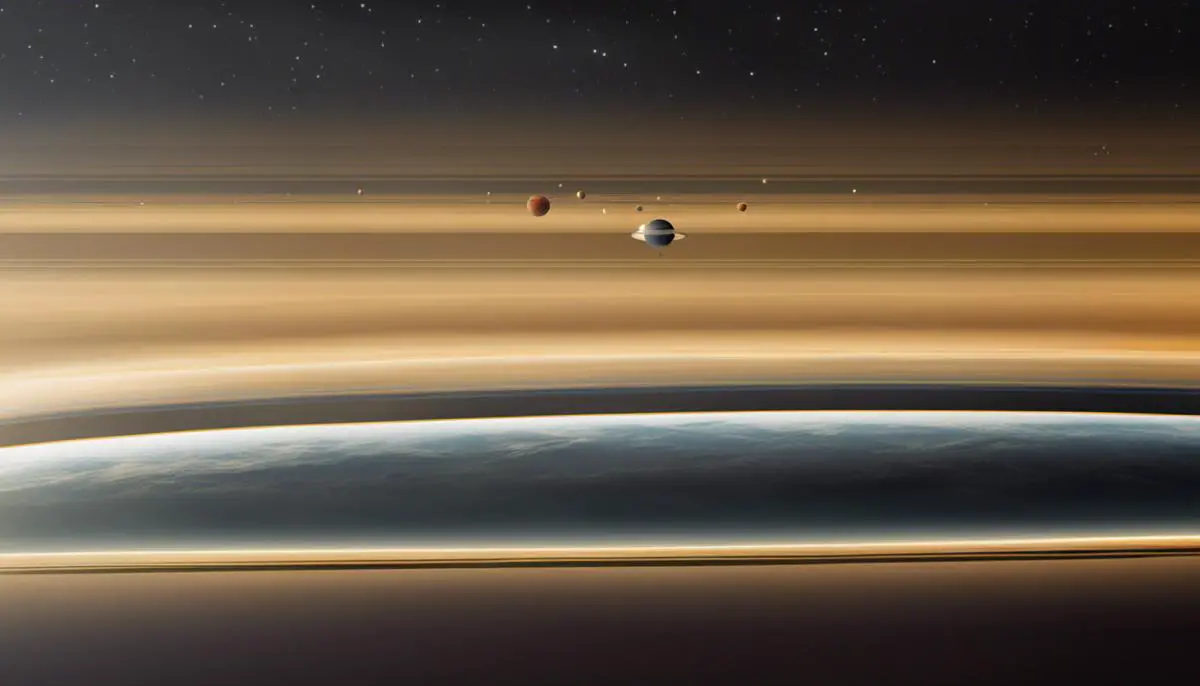
Saturn’s Temperature Extremes
The Frigid Temperatures of Saturn
Being the sixth planet away from the sun, Saturn, a gas giant, faces staggeringly cold conditions. The temperatures at the cloud tops average around a bone-chilling -285 degrees Fahrenheit or -175 degrees Celsius. This level of cold is primarily due to Saturn’s considerable distance from the sun, about 9.5 times the average distance between the Earth and the sun. Even though temperatures differ noticeably across various layers of Saturn’s atmosphere, all remain incredibly cold by Earthly standards.
Temperatures Variability Across Atmospheric Layers
The temperature of Saturn’s atmosphere varies greatly with altitude. The outermost layer is the coldest, with temperatures around -285 degrees Fahrenheit. Going deeper, the temperature increases gradually. The next layer down, where the ammonia clouds exist, shows temperatures near -125 degrees Fahrenheit (-87 degrees Celsius). Proceed still deeper to where the water vapor clouds exist, and the temperature rises to 27 degrees Fahrenheit (-3 degrees Celsius). The core temperature of Saturn is estimated to be extremely high, around 21,000 degrees Fahrenheit (11620 degrees Celsius), due to the pressure and heavy elements.
Fluctuation Between Day and Night
Temperature fluctuation between Saturn’s day and night is minimal. This is because a day on Saturn is only 10.7 hours long; the planet has a rapid rotation. The swift rotation distributes heat evenly from the day side to the night side, preventing significant temperature differences. The thick, hazy atmosphere also disperses sunlight, further reducing the temperature dichotomy. This lack of extreme temperature differences inhibits strong weather fronts and storms due to day-to-night transitions.
The Role of Cold Temperatures on Saturn’s Weather
Saturn’s weather conditions are largely influenced by the low temperatures in its upper atmosphere. This allows for high, thin clouds of cirrus, comprised of ammonia or ammonia hydrosulfide crystals, to form. The bands of these clouds somewhat resemble those on Jupiter, though they are less striking in nature.
Remarkable storm activity is seen on Saturn, partly due to the internal heat generated by the planet’s gravitational compression and the segregation of helium from hydrogen. These storms produce dramatic white spots, some of which are large enough to be seen from Earth with amateur telescopes. The temperature differences between the upper and lower atmospheric layers result in turbulent motions that give birth to these storm systems.
Furthermore, Saturn boasts a unique hexagonal storm on its north pole, a feature unseen on any other planet. The dynamics of the wind and the varying temperatures shape this peculiar phenomenon. Polar vortices like this one seem to be more prevalent in gas giants; their formation is heavily influenced by large temperature gradients.
In conclusion, though Saturn’s extreme temperatures may seem inhospitable, they contribute significantly to crafting the planet’s intriguing and varied weather patterns.
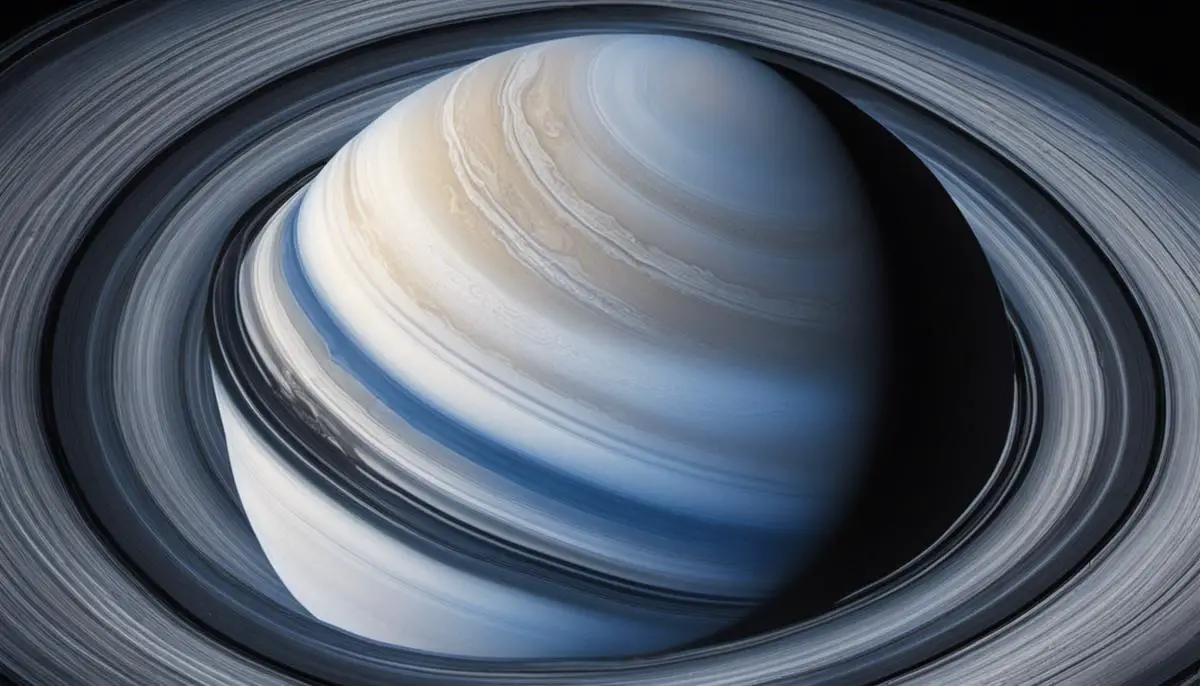
Effects of Saturn’s Rings on its Weather
Interrelationship of Saturn’s Ring System and its Weather
Saturn, the sun’s sixth planet, is well-known for its impressive ring system. The system is predominantly made up of ice particles, with a smaller proportion of rocky debris and dust. It extends up to a whopping 175,000 miles from the planet, thus playing a noteworthy part in sculpting Saturn’s weather patterns.
The glorious series of rings, casting shadows over certain areas of the planet, significantly affect Saturn’s temperatures. During an equinox, the ring system’s shadow deprives certain areas of Saturn’s atmosphere of sunlight. As a result, there is a pronounced change in Saturn’s weather patterns, which leads to a temperature drop in the northern hemisphere during the winter equinox.
Moreover, such ring-shadow effects manipulate the movement of gases in the planet’s atmosphere. The shadows create temperature differentials between the shaded and sunny areas, causing winds to originate. Consequently, Saturn’s beautiful rings indirectly impact the planet’s unique weather system.
Effects of Ring Material on Saturn’s Weather
The icy particles from Saturn’s rings also contribute to the planet’s weather systems. These icy particles, along with other ring materials, descend into Saturn’s upper atmosphere through its gravitational pull. The material from the rings provides a source of energy for the planet’s atmosphere as it breaks up or burns up, releasing heat in the process.
These particles, referred to as “ring rain,” have a direct influence on Saturn’s equatorial weather patterns. During the ring rain occurrence, scientists have noted an increased atmospheric density and a decreased temperature at Saturn’s equator.
It’s also worth noting that the ring materials interact with the planet’s magnetic field, causing fluctuations and affecting the planet’s upper atmospheric winds. Hence, the contribution of ring material is dual in nature; it affects both the temperature and atmospheric composition of Saturn.
Exploration by the Cassini Spacecraft
Insights about Saturn’s weather and its relationship with Saturn’s rings have been primarily provided by NASA’s Cassini spacecraft. It was Cassini who discovered the ring-shadow effect and the phenomenon of ring rain. It made several surprising discoveries while in orbit around Saturn between 2004 and 2017, which transformed our understanding of the planet. It revealed that the shadows of the rings cause seasonal variations, and these changes have significant implications for understanding the nature of Saturn’s weather. Further study will continue to unravel how these two defining features of Saturn interact in a symbiotic relationship, continually shaping the planet’s fascinating meteorological phenomena.
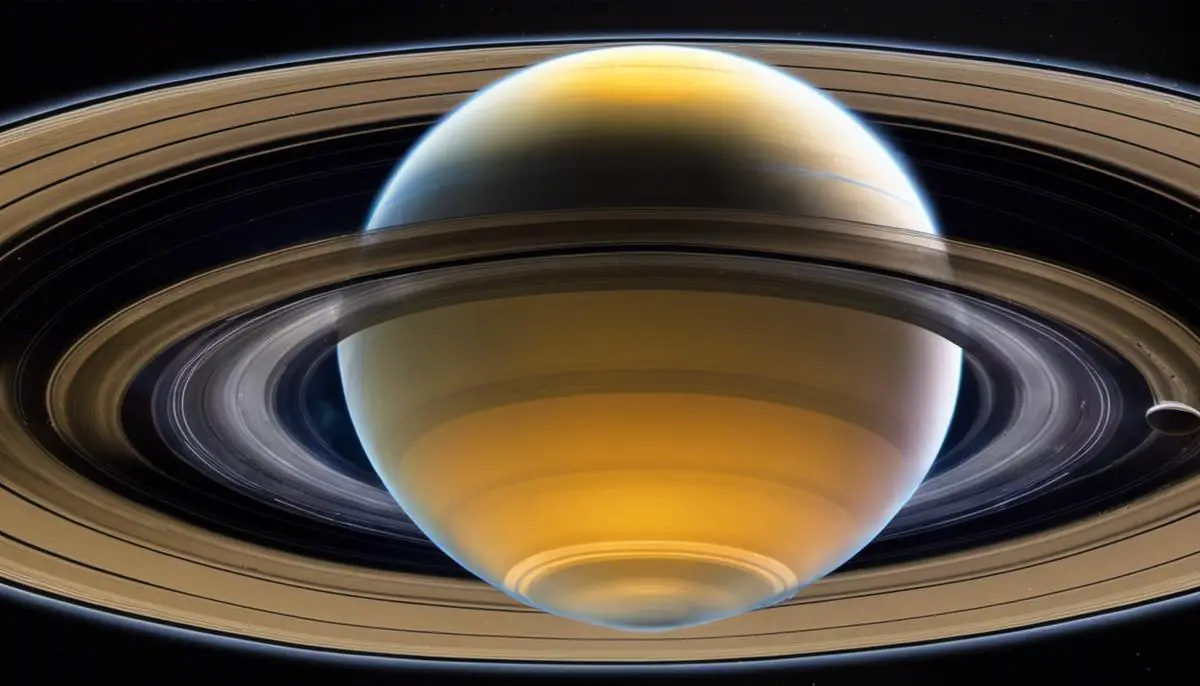
Through an exploration of Saturn’s atmospheric structure, storms, seasons, temperature extremities, and the interaction of its rings on its weather, we get to unravel the complexities that define the weather systems of this beautiful ringed planet. Saturn’s approach to weather, which is characterized by extreme and distinctive traits, not only highlights the diversity of our solar system but also deepens our understanding of atmospheric processes. As we continue to gather more knowledge about Saturn’s weather and the mechanics behind its impressive storms and seasonal shifts, we lift the veil on the secrets of one of the solar system’s most iconic planets, bringing us closer to the cosmic ballet that plays out beyond our own world.
![]()
